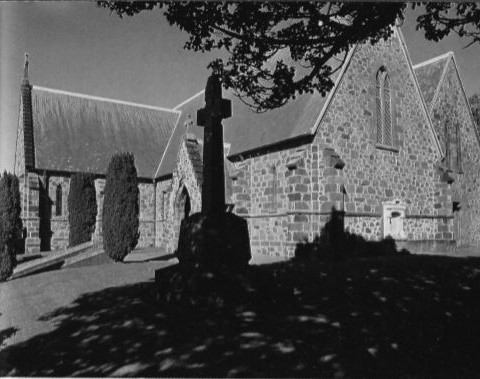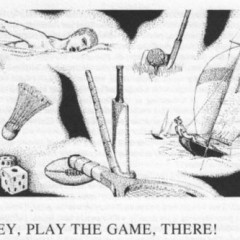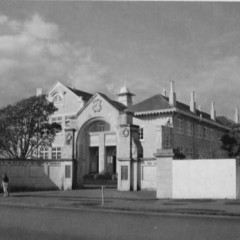13
'It is curious that the English cannot settle down quietly, even in a new country, without wasting their time and money on these two most absurd of all absurdities-namely, horse-racing and public dinners.This 1864 comment by Alexander Marjoribanks was a bitter reflection on the English passion for the thoroughbred which the pioneers speedily expressed in their new home, and as speedily transmitted to the Maoris. The Scottish writer's fulminations carried no weight with the New Plymouth colonists. But indulgence in the Sport of Kings required more than the five drought horses and two hacks which the settlement possessed in 1842: even these were pressed into service, with a few of the more adventurous souls matching their mounts for a few pence. 'The anniversary of the Amelia Thompson arriving at New Plymouth was celebrated this day (Wednesday, September 25) by rifle shooting, racing, greasy pole climbing, wrestling, etc.'2 The first 'official' Anniversary Day was held at Ngamotu Beach the following year. By 1848 New Plymouth boasted 52 horses of varying quality, and the Maoris possessed a few of which they took great care. The first 'official' race meeting took place on New Year's Day, 1849, on a course at Spotswood. John Hursthouse wrote in his diary: 'Every cart and carriage was in requisition for the use of the fashion and beauty of Taranaki. By 12 o'clock the town was comparatively deserted. Officials were: Stewards, Edward Dorset, Edwin Davy, Thomas Standish; Secretary and Treasurer, E. Davey; clerk of the course, W. K. Hulke; Judge, J. Hursthouse.' Hursthouse does not record details of the racing, but 'the meeting passed off without accident or occurrence to mar the general pleasure of the first meeting of the Taranaki races.' Nearly five years passed before, on December 31,1853, a meeting of Ornata settlers 'made a first effort for the resuscitation of these noble sports' on January 10 at which 'there were a number of false starts boltings and crossings, with a large and gay assembly mustered on the course'. Later, at a meeting in the Ship Inn, it was resolved: 'It is expedient and desirable that a race meeting take place in Taranaki on the 31 st March and 1 st April next, to celebrate the 13th anniversary of the founding of the settlement.' The course was on Maoricote Hill, an area of rough ground near the present Boys' High School, crossing and recrossing A venue Road (now Coronation Avenue). 'The races', reported the Taranaki Herald, 'with the exception of the hurdles, were run in the form of heats, and in some races the horses had to cover the distance as many as four times before a decision was reached. Two wins in heats were necessary to win the prize. Horses that made a poor showing were usually withdrawn in later heats. Horses that were "distanced"-a certain distance from the winner-were disqualified. The number of entries in each race varied from three to nine . everything went off to everybody's satisfaction. The grandstand was used as a booth and both C. W. Foote of the Ship Inn and D. Godfrey made ample provision for the patrons.' A report of the second day's racing said: 'Town again became the order of the day and another well-spread board awaited all hungry appetites at Mr Foote's hotel. Mirth and music were not wanting to add their charms to this reunion. And thus, without an accident to mar the general holiday, did we commemorate our thirteenth anniversary.' Experience gained at this meeting brought an improvement the following year, when racing was held 'under Nelson Jockey Club's rules' .
A Ladies' Purse of $100 over one mile and a half was included in the programme. Although the course was much improved and 'a large proportion of beauty and fashion of Taranaki was present', riding gave cause for complaint. 'Jostling, crossing, striking or some acts amounting to disqualification occurred to such an extent that the rule excluding Native riders from European races is, in some instances, applicable to our own riders; for while the former err from ignorance, ours do so from design,' said the Herald. For three more years two days of anniversary racing were enjoyed. In 1859 the 'hero of the meeting' was the aged gelding Black Jack, owned and ridden by a New Plymouth butcher, G. Lethbridge. Hostilities put a stop to racing in 1860, for 'the course was not even safe to be on,' said the Herald. In 1862 the military garrison staged a three-day meeting on March 19, 20, and 21. 'The Taranaki horses bore sad evidence of the effects of the war, the few left by the Maoris being either advanced in years, or brood mares which, for a long period, have greatly suffered from being kept in small paddocks with a very limited supply of grass. From these causes the few of our old favourites remaining were both deficient in condition and training, which more particularly told against them from the heavy state of the course,' said a contemporary report.
In 1866 times were easier, but military horses and their riders still made the greatest impact. 'St Patrick won three races to a total value of $80.' said the Herald, adding' A feature of this meeting was the presence of some Maori ladies in full riding costume mode a la Paris and fully conscious of their charms ... mounted orderlies during the day were busy driving offthe dogs and wild youths who will run across the course just as the horses are coming round.' In 1867 the anniversary races were held on Mr Rundle's farm at Bell Block and the following year races were back on the town course which was 'very heavy, with wheat and potatoes having but recently been gathered' . That year the Taranaki Cup, worth $40, was won by Mr McDonald's aged mare Maggie at even money, in spite of the rule that there should be 'no gambling or other improprieties on the course.' One of the dead-heat winners of the 1870 Taranaki Plate was disqualified because bags of sand (used as handicap weights, instead of the former heat system) burst during the race. The military's departure in 1871 left the district with little desire for racing, and when two years later meetings were resumed they were conducted so badly and there was so much disorder-one full-scale fight developed in front of the crowd-that 'respectable' patrons were moved to protest.
This was one of the reasons which led to the formation ofa short-lived Taranaki Jockey Club in 1873 when Major Tuke, Dr O'Carroll, A. Standish, D. Atkinson, J. Paul and H. Hatley banded themselves into a committee with support from about 60 other men. The first meeting under their auspices took place on April 6 and 7, and a great improvement was noticed. Something of a carnival nature was created by the presence of sideshows: 'There were three booths; Mr Gyde had his swing there which was extensively patronised,' noted the Herald, 'and we noticed an old racecourse sort of roulette at which some staked their half-crowns (25c). ' This jockey club went into recess after two years, but by 1876 the affairs of the settlement looked brighter. Emigration had restarted; under the impact of the Vogel public works policy work on the railway was well under way and people had more spending money than they had possessed since 1860. 'The Taranaki Jockey Club shook itself into life and made a real start that proved a worthy effort,' said the Herald. The meeting on March 30 and 31 included the Taranaki Cup of$100, of two miles weight for age. This was won by Opawa, who also finished first in three other races on the two days. Opawa was owned by J. W. Jackson, ofWanganui, who walked the horse from that town to New Plymouth. He covered a racing distance of seven miles and five furlongs to win his four races. (He also won the 1877 Taranaki Cup.) At the first meeting nearly 2000 people were present, including a large number who had alighted from the train at Eliot Street, the nearest station to the course. A judges' box had been erected, and repairs and additions made to an old stand. 'It was,' said a reporter, 'the most important meeting yet held in New Plymouth.' The Taranaki Jockey Club regards it as the first meeting; it celebrated its centennial in March, 1976. Improvements to the course were made in spite of financial problems. After years of argument the club acquired a lease in perpetuity from the Town Board. A large stand was built in 1885 for $1300, and the main stand, which served the club for more than 70 years, cost $3400 in 1903. Robert James Matthews, who died in New Plymouth in 1947 at the age of 95, had close association with the turf, including the Jockey Club. Manager ofthe Waitara branch of the Bank of New Zealand for 35 years until his retirement in 1908, he owned several racehorses. But because he was a bank manager, such activities were frowned on and he conducted his racing affairs under the name of Shaw. One of his horses was Star Rose, which he trained on his farm at Waitara. It had performed creditably at New Plymouth, and when he entered it for the New Zealand Cup in 1905 he put a bet on it for 12 of his friends, without telling them. The horse won by 15 lengths and paid $102. Twelve very surprised men later received $51 each from 'Mr Shaw'. Matthews also owned au ida, one of the most successful brood mares of her time (dam of Artillery, a stallion who had a successful stud career in America), and Flying Fish. This horse was so little known to the racing public that out ofa pool of about $1200 on the private totalisator at New Plymouth on Boxing Day, 1895, only $26 was invested on her chances, most of the tickets being held by her owner.
When she won, Matthews found that the totalisator didn't have sufficient money to pay him his $1000 until later in the day, and when he did collect he spent the rest of the meeting with notes of all denominations in all his pockets- some tied up in his handkerchief. Among the many great horses which have paraded before the New Plymouth crowd were G. A. Nicholson's Vedette; Jervis George's Paritutu; Lady Medallist, The Hawk, Lord Manna and Deceptive, all of whom have won the Taranaki Cup. Other great gallopers who have thrilled the crowd include Desert Gold, Gloaming, Kindergarten, Sleepy Fox and Mainbrace. There can be few educational bodies in New Zealand which have such .a vital interest in the turf as the New Plymouth High School Board. The Wynthorpe Stud at Tikorangi, near Waitara, was founded in 1950 by L. A. (Allan) Alexander, whose family had farmed the 70haproperty since 1908. Starting as a hobby (with the help of stallions like Mr Cute, Rolled Gold, Copenhagen II; an Irish mare, Irish Eyes, and other thoroughbreds), he developed the stud until it was one of the best known in Australasia. When he died in 1968 his estate was administered by the New Zealand Insurance trust department and Stan Florence, who had been his accountant since 1949. Allan was dedicated to farming-and to the youth of the district-and his views on education were as positive as they were on agriculture. He felt there should be an agricultural seat of learning closer to home than the nearest-Massey University. Under the terms of his will the trustees were charged with administering the estate with the objective of establishing an agricultural college under the control of the high school board. In 1980 (when the value of the stud's assets was estimated at more than $1 million) a proposal to operate a limited type of outdoor classroom block to be built on the Tikorangi property was under consideration by the board and the trustees. Coincidentally, at the time of Allan's death, his brother, W. E. ('Whit') Alexander, was deputy principal (later to be principal of the Boys' High School). The stud book records Copenhagen II as the champion New Zealand sire for two seasons as well as the champion sire of two-year-olds for three seasons. His most famous daughter was La Mer, born in 1973. When she was sold in 1979 to Captain A. D. D. Rodgers of Dublin, one of the top studmasters in Europe, she was regarded as the best of her sex since Desert Gold raced during World War One, and had earned nearly $250,000 in stake money.
Although trotting has been enjoyed in New Zealand since 1868 when the first controlling body for the sport was set up in Wellington, it was not until February 7, 1920, that the Taranaki Trotting Club was formed in New Plymouth. First president was A. W. Webster and his secretary, D. Le C. Morgan. The club has never been a large one and its career has had its difficulties. It raced annually, usually in April, until in the depression the Hawera, Wanganui and Taranaki clubs combined in drawing up programmes and meetings were held on their respective courses, with mixed financial success. Since 1959 its Easter carnival has resulted in a change of fortune. At the 50th jubilee meeting at the racecourse on April I I, 1970, the star attraction was a parade by the New Zealand champion trotter, Cardigan Bay, owned by Mrs A. Dean and driven by C. S. Hunter.


